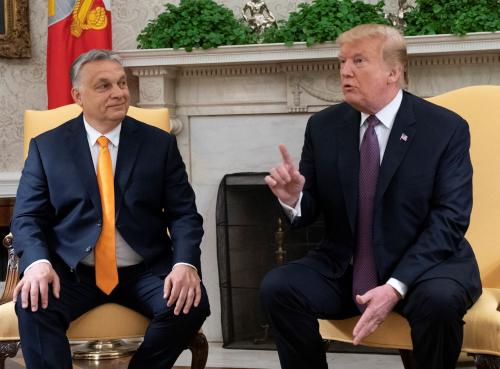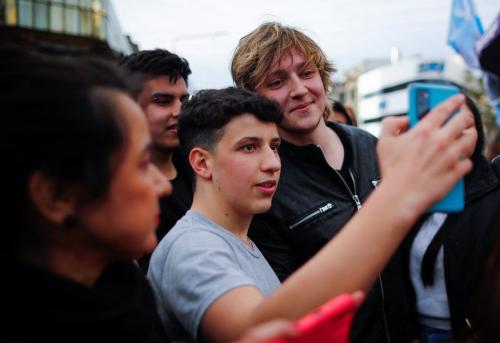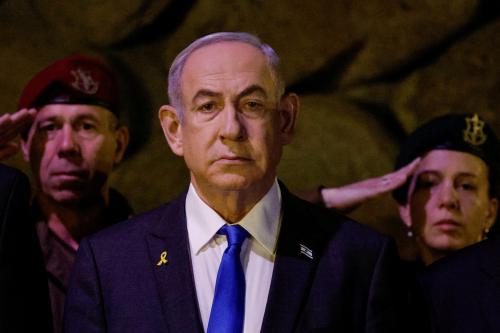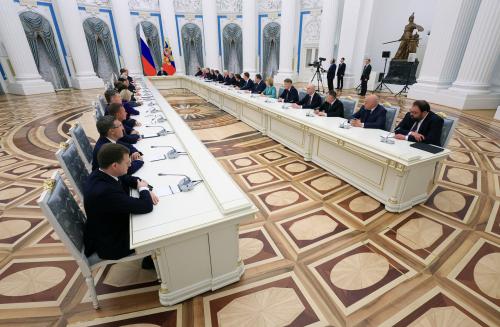Over the past year, TikTok has emerged as a bipartisan target in the United States, with politicians on both sides of the political spectrum raising concerns about Chinese ownership of—and potential influence over—the social media platform. Among these critiques is a worry that Chinese messaging could more readily reach young Americans, who are a majority of the platform’s user base in the United States. This led, in late April 2024, to the passage of a bill in Congress that requires ByteDance, the company’s Chinese owner, to divest from TikTok over the next year or risk a ban of the app across the United States.
Yet, much like other social media platforms, TikTok’s viral content is not limited to Chinese state-backed accounts. Amid a fracturing of the online information space, marked by the growth of platforms that cater to more targeted audiences, Russia’s state propaganda apparatus has begun to leverage TikTok’s growing appeal as a new avenue for disseminating overt Kremlin messaging through a network of state-affiliated accounts. How has Russia shifted its approach to capitalize on TikTok’s expanded reach and appeal? How does this compare to the activity of state-affiliated accounts on other prominent platforms, such as X (formerly Twitter) or Telegram? And what has been the focus of messaging from these TikTok accounts thus far? To answer these questions, I draw on data from Russian state-affiliated accounts on TikTok, Telegram, and X. I find that:
- Russian state-affiliated accounts have accelerated their use of TikTok since the start of 2024: In 2022, 57 accounts posted at least once during the year, with just one posting on average twice per day. In 2024 so far, 46 accounts have posted, with three averaging 10 or more posts a day. However, the number of active accounts on TikTok, and the number of posts per account, still lags far behind accounts on Telegram and X.
- Although Russian state-affiliated accounts are far more active on other platforms, engagement per post on TikTok is much higher: 44 of the top 50 most engaged with posts in 2024 hail from TikTok, while the remaining six were shared by accounts on X. These posts on average have drawn over 3.5 million engagements. On average, TikTok posts draw approximately 100,000 total engagements per post, 3.5 times the rate of Telegram and 20 times the rate of X.1 If we remove views, which may be measured differently across platforms, engagement per post is still 13 times higher on TikTok than on X.2
Russia’s experimentation with TikTok is particularly timely. Amid contested elections in the United States and elsewhere, the results could dramatically reshape support for Ukraine and NATO. Against this backdrop, Russia’s malign influence operations are likely to continue, according to a recent report by the Office of the Director of National Intelligence. Based on an analysis of TikTok posts from the first three months of 2024, I find that:
- Posts pertaining to U.S. politics make up a small percentage of overall content shared by Russian state-affiliated accounts, but they represent a slightly higher percentage of total posts on TikTok than on X or Telegram: Across all platforms, content tied to U.S. politics makes up around 3% of all content shared by these accounts. However, on TikTok, 5% of all posts in 2024 cover U.S. political topics, as compared to 4% on X and 1% on Telegram.3
- Spanish-language posts focused on U.S. politics are among the most popular on TikTok: 22 of the top 30 most engaged with TikTok posts tied to U.S. politics are in Spanish. The success of Spanish-language content across TikTok mirrors similar successes across other platforms, including X and Facebook, where Russian accounts like RT en Español and Sputnik Mundo regularly draw large audiences and high engagement.
- Among posts about U.S. politics on TikTok from Russian state-affiliated accounts, wedge issues feature prominently: Thus far, messaging about U.S. politics has focused on questions about President Joe Biden’s age, protests over Biden’s Israel policies, and political commentator Tucker Carlson’s reflections on Russia and U.S. policy toward Russia, among other topics. Some of these themes are clear wedge issues that shape political debates and are likely to resonate with young audiences, who make up the majority of TikTok’s U.S. user base.
In tandem with shifts in covert influence operations, Russia’s overt messaging has begun to adapt to an evolving information ecosystem made up of many more platforms with distinct identities. The use of TikTok highlights a growing, but still not fully realized, avenue for Russia’s state-backed information apparatus to reach new, young audiences. Additional research to better understand the trajectory of Russia’s engagement moving forward and how these narratives spread across TikTok will be valuable. Despite ongoing questions about the future of TikTok’s ownership, it remains critical to not wholly ignore or disengage from the platform entirely. Much like on other social media websites, Russian state-affiliated accounts are finding a receptive audience. As a result, transparent and proactive pushback against Kremlin narratives is vital to countering their spread ahead of the 2024 elections and beyond.
Russia’s growing reach on TikTok
As the social media landscape continues to evolve, Russian state-backed accounts have broadened their online strategies to incorporate more regular content creation on TikTok. Drawing on data from 70 different state-affiliated accounts, I find that the use of TikTok has grown rapidly over the past year.4 In 2022, 57 accounts posted at least once, with only two posting 500 or more times total, and one account (sputnik.kg) posting on average twice per day. Ruptly, a Russian-backed website featuring video content targeted to younger, left-leaning voters, was the among most active during this early period.
By 2023, fewer accounts (48) posted at least once, but six shared over 1,000 posts that year, or around three per day. RT en Español, one of Russia’s most effective state-back media endeavors overall and a popular outlet for Russian narratives to reach Spanish-speaking audiences in Latin America, the United States, and Spain, posted nearly 3,000 times in that year, or over seven posts per day. In 2024 so far, 46 accounts have posted, with three averaging more than 10 posts a day. Due to the sampling process, many of these accounts are now labeled by TikTok as “state-controlled media,” which up until recently had not always been the case.
Figure 1 plots the growth in total TikTok posts and posts per account since January 1, 2022. As new accounts have come online, unsurprisingly, the total number of posts has steadily climbed. However, since the start of 2024, Russian state-backed accounts have also begun to post more frequently on TikTok. Throughout 2023, these accounts posted between two and three times a day. Since the start of 2024, that number has doubled to around four or five posts per day, highlighting a growing attention to the platform.
In tandem with an increase in posts, engagement with state-affiliated accounts has grown. As Figure 2 highlights, engagement, which includes likes, views, shares, and comments, has steadily climbed over time. In 2022, the posts of Russia’s state-affiliated accounts garnered three million engagements per day, anchored by 14 massive days of engagement around the invasion of Ukraine. In 2023, that number doubled to around six million per day. And in 2024, engagement has more than doubled again, to 13 million per day. However, Figure 2 also highlights that this engagement has not yet corresponded with an overall increase in engagements per post. Additionally, in terms of raw engagement numbers, it also has yet to match the massive spike in engagement registered right after the invasion of Ukraine in February 2022, when a handful of posts generated nearly a million engagements each. While X and Facebook received significant scrutiny for amplifying Russian state-based content around the invasion, TikTok content did not face nearly as much criticism, despite this clear surge. This is likely due in part to the fact that the number of posts from affiliated accounts on TikTok was so much smaller when compared to Facebook or X.
How TikTok usage compares to other prominent platforms
Although Russian state-backed accounts have begun to post more on TikTok in 2024, they still largely emphasize other platforms to spread Kremlin messaging about current events, including Telegram and X.5 Figure 3 plots the average number of posts per day by active account across the three platforms. Not only do Telegram and X have far more state-backed accounts posting on any given day, but they also post three to four times more frequently.
Despite this imbalance, Figure 4 shows that engagement with posts on TikTok is far higher than engagement with posts on Telegram or X, although there are some accounts on Telegram that block all types of engagements except views. Of the top 50 most popular posts in 2024 thus far, accounts on TikTok shared 44 of these posts, while accounts on X posted the remaining six. These top posts averaged 3.5 million total engagements.
Beyond the most popular posts, average engagement per post is also far higher on TikTok than on X or Telegram. On average, TikTok posts draw approximately 100,000 total engagements per post, or 3.5 times the rate of a Telegram message and 20 times the rate of an X post. Across all three sites, views are by far the primary driver of engagement, but views are also measured differently by platform. If we exclude views and focus on likes, shares, and comments exclusively, engagement per post is still 13 times higher on TikTok than on X.
How Russia is using TikTok in the lead-up to the U.S. election
The increased presence of Russian state-backed accounts on TikTok coincides with the start of the 2024 U.S. presidential election cycle. As such, TikTok’s appeal to young voters in the United States offers an optimal avenue to spread Russian messaging about the U.S. political climate to a critical voting bloc whose turnout has the potential to decide the election. What is the scope and substance of Russia’s overt messaging about U.S. politics on TikTok thus far? And is it designed to appeal to this younger demographic?
To answer these questions, I developed a dictionary of key terms tied to U.S. politics and searched posts since the start of 2024 for references to these terms. I find that posts pertaining to U.S. politics comprise only a small portion of content shared by Russian state-backed accounts across Telegram, TikTok, and X thus far, although that could change as the electoral contest becomes more acute. Terms tied to U.S. politics are referenced in just 3% of all posts—or around 9,000 times in over 300,000 posts. Yet I find clear variation across platforms as well. Given X’s historically elite appeal with journalists, politicians, and other public figures and regular coverage of political topics through an algorithmically curated news feed, one might expect X’s content to skew more political. By contrast, given Telegram’s limited popularity in the United States and opt-in nature, which requires users who already agree with or endorse the content to explicitly sign up to receive it via a messaging app, the content could in theory be less political. TikTok, given its relative novelty, young audience, and algorithmically curated video-based feed, may trend more toward content that is less politicized and more entertaining.
Despite these expectations, among accounts tracked in this analysis, I find that TikTok content has so far been the most focused on U.S. political topics, with 5% of all posts referencing political terms. X is also more political than the aggregate average, with 4% of all posts referencing the same dictionary. Telegram, as expected, is the least focused on U.S. politics—with just 1% of all posts referencing political terms.
As Figure 5 highlights, engagement with politically charged posts also varies by platform. While political content on X garners nearly double the engagement as non-political content on average, on Telegram political content gets only 3% of the average engagement of a post that does not reference U.S. politics. This suggests that the followers of Russian state-affiliated accounts on the encrypted messaging app, which surged in popularity in the aftermath of the invasion of Ukraine, have little interest in U.S. political content and are instead focused on other types of content, such as coverage of breaking news around the war. On TikTok, however, average engagement with content focused on U.S. politics and average engagement with other content is about equal. Regardless, this engagement on TikTok is still on average 10 times higher than engagement with U.S. political content on X.
Among the 30 most popular posts focused on U.S. politics, 20 were shared on TikTok and 10 were shared on X. Among the 30 most popular TikTok posts focused on U.S. politics, 22 come from Russia’s Spanish-language accounts, which have the benefit of reaching not only audiences in Latin America and Europe but also Spanish speakers in the United States–another critical voting bloc in the upcoming U.S. elections. These findings mirror results from my prior coauthored research, which identified the similar success of Spanish-language content in the aftermath of the invasion of Ukraine across other platforms, including Facebook and X.
In an analysis of approximately 600 TikTok posts from 2024 that were flagged by the dictionary of key terms, I found several prominent themes. Unsurprisingly, Ukraine and NATO, as well as the prospects of a broader conflict with Russia, featured prominently in posts. TikTok accounts also regularly referenced Tucker Carlson’s interview with Russian President Vladimir Putin, conducted in late February 2024. The references highlight Carlson’s remarks about misperceptions of Russia’s intentions and his appreciation for the beauty of Moscow, among other praise. Segments also emphasized the criticism he faced for wanting to interview Putin and claimed that Carlson would be detained if he was too nice in his questioning of Putin.
Beyond issues of immediate concern to Russia, wedge issues driving voter preferences—like immigration, the war in Gaza, and Biden’s age—also regularly surface in state-affiliated TikTok content. Despite efforts to highlight that Putin would actually prefer Biden to win the presidency in 2024, one of the most prominent themes in TikTok posts focused on Biden’s purported age and fitness for office. These posts frequently highlighted verbal gaffes and questioned who was really running Biden’s foreign policy. A few posts also focused on Biden’s handling of classified documents.
Where Donald Trump was featured in Russian state-backed TikTok content, posts have focused on his humor, stance on NATO, and limited-edition shoe line. When posts mentioned Trump’s legal issues, they highlighted the former president’s own statements about the “weaponization of the [Department of Justice].” A few posts also criticized the security of U.S. elections in comparison to Russia’s and speculated that the 2020 election was rigged.
Countering Russia’s growing focus on TikTok
Russia’s increased presence on TikTok does not necessarily mean that this content will impact voter preferences in any meaningful way. In fact, recent research has found that exposure to Russian narratives on Twitter in 2016 was highly concentrated, received relatively small engagement, and, at least in isolation, did not meaningfully alter voters’ beliefs. However, the trends presented above highlight a clear shift in Russia’s overt strategy for disseminating its preferred messaging abroad around topics of domestic importance to platforms beyond X. This shift also complements ongoing adaptations in more covert information operations, which—with the ubiquity of generative AI outputs—may lead to the creation of higher volumes of more credible or persuasive content. Furthermore, while exposure may not change beliefs, it may impact voters’ willingness to mobilize or take actions that benefit the target of false or hyperpartisan content, a question I explore in ongoing coauthored research.
Unlike previous efforts, these narratives are also finding far wider audiences on TikTok than on other platforms, as demonstrated by the high engagement rates with each post.6 This likely means that Russian state-backed accounts will continue to shift more resources and bandwidth toward reaching audiences on the platform, which remains one of the fastest growing in the United States, with particularly high usage among younger audiences. A sale of TikTok to a U.S.-based company will likely not change this calculus. As a result, additional efforts by researchers to investigate the scope and influence of Russian propaganda in a pivotal election year—both in the United States and elsewhere—should remain a priority. As a platform, TikTok can play a vital role in accelerating researcher data access to help explore these trends in depth and at scale, while facilitating the design of causally identified research to measure behavioral effects beyond persuasion.
Finally, avoiding the platform entirely or exclusively focusing on the potential for Beijing-approved messaging to reach audiences distracts from the reality that TikTok is a contested information space, much like any other social media platform. Overlooking the reach of Russian content—or Kremlin-approved messaging—instead allows these narratives to circulate widely and without pushback. This is particularly risky when considering that recent U.S. government efforts to be more proactive in the information domain, including publicizing Russia’s plan to create a false flag attack to justify the invasion of Ukraine, have found some success. As such, engagement with and timely debunking of these narratives, where possible and appropriate, remain critical.
-
Acknowledgements and disclosures
The author would like to thank Adam Lammon for editing and layout.
-
Footnotes
- Total engagement measures the sum of likes, shares, views, and comments.
- The main form of engagement on Telegram is views and some accounts turn off other reactions. Therefore, I exclude Telegram from this analysis.
- U.S. political content consists of posts that reference any of the following terms: kamala, kennedy, nato, otan, jan 6, trump, biden, united states, blinken, cia, fbi, nuland, voter fraud, stolen election, fake democracy, carlson, and us election. These terms were selected because they explicitly touch on U.S. election topics and political actors prominent in Russian messaging. However, they likely underestimate coverage of specific policy issues (like immigration or inflation) that are not only a focus of election-related debates in the U.S. but also prominent points of conversation in other country contexts as well.
- Russian state-affiliated accounts on TikTok were identified in two different ways. First, I searched for corresponding TikTok accounts from a list of accounts tracked by the Alliance for Securing Democracy’s Hamilton 2.0 Dashboard, which tracks X, Facebook, Rumble, YouTube, Instagram, and Telegram usage for 479 media and government accounts. For accounts with a TikTok presence, I then looked at who those accounts followed for any additional profiles with a “Russia state-controlled media” label. More information on these labels can be found here. In total, I identified 70 different accounts. These accounts primarily include media websites, known influencers, and journalists, with far fewer embassies and political figures present on TikTok, as compared to X or Telegram. All data was collected through Junkipedia, a social media monitoring platform developed by the Algorithmic Transparency Institute, part of the National Conference on Citizenship. All data collection for 2024 runs through March 24, 2024.
- Russian state-affiliated accounts on Telegram and X were pulled directly from ASD’s Hamilton 2.0 Dashboard list of monitored accounts.
- Importantly, given the lack of traditional “elites”—including many politicians, media outlets, journalists, and other public figures—on TikTok, X content may still be more impactful for this audience even if it doesn’t reach segments of the public as readily.









Commentary
Tracing the rise of Russian state media on TikTok
May 2, 2024